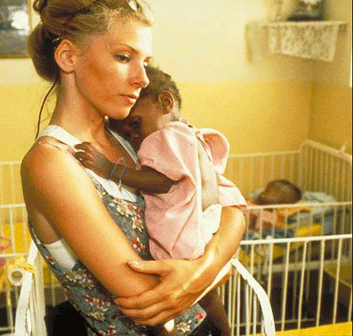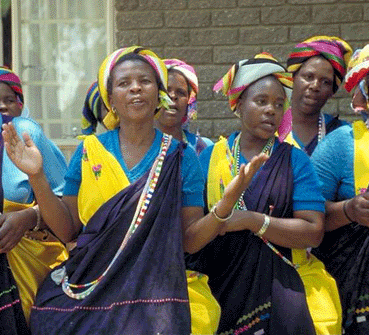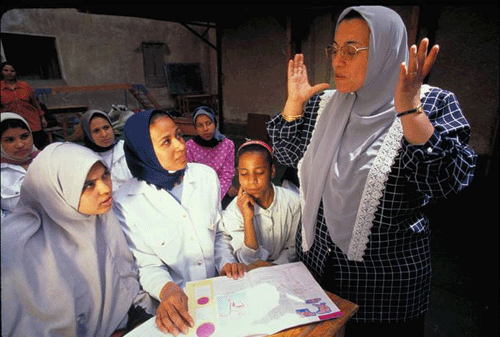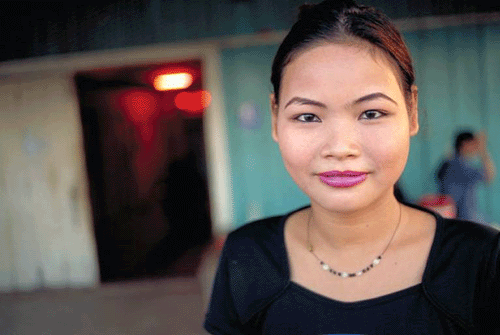| How America Aids and Abets AIDS/HIV Worldwide The Health eZine - Disease Control
Funding Gaps from AmericaEach year, UNAIDS promotes World AIDS Day, an international day of support for people living with HIV/AIDS. One hope is that the informed public will pause and take stock of the current obstacles to global AIDS prevention and relief. President Bush’s signing of the U.S. Leadership Against HIV/AIDS, Tuberculosis, and Malaria Act of 2003 into law served as a reminder that sex workers also make a difference. A stated purpose of this law is to allocate funds to programs working to stem the spread of HIV/AIDS in countries hardest hit by the pandemic. However, buried within the act is a funding limitation that works counter to this goal: "No funds made available to carry out this Act, or any amendment made by this act, may be used to provide assistance to any group or organization that does not have a policy explicitly opposing prostitution and sex trafficking." Such a provision may come as no surprise to those familiar with the Bush administration’s abstinence-only approach to high school sex education in the United States, which labors under the assumption that being straightforward with teens about sex and safe sex practices equates to encouraging them to have sex. Surprising or not, this latest attempt to appease the religious right, in forcing organizations to ignore a population at the heart of the pandemic, could have dire consequences for the global battle against AIDS.
No anti-AIDS program uses US money to promote sex work. Neither, however, do they make it their principle aim to remove sex workers from voluntary prostitution, something which the law does not even define. Must actual currency change hands, for example? In many developing countries women have “transactional sex” with men. The woman provides sexual favors, and the man brings food or clothing in return (“Prostitution v constitution”). Nor does the law stipulate how public health organizations are supposed to express their opposition to prostitution. This lack of clarity has led some groups to guess which of their projects could be construed as encouraging it. As a result, units working in Cambodia have stopped providing free English-language instruction to sex workers, although the project was started to provide these women with critical skills for moving away from sex work and into the mainstream labor market. At the same time, religious groups in Central America continue to receive USAID funding for projects that can be described as absurd at best. One such project is the distribution of fliers to sex workers asking them to adopt the infamous “ABC” approach, which is short for “Abstain. Be faithful (to a mutually faithful uninfected partner). Condomise”.
The governments of some countries simply will not leave sex workers, whom they regard as equal citizens, behind. Senegal has already lost access to US funds, as its government refuses to change a 1969 law legalizing prostitution. The irony is that Senegal has one of the lowest HIV prevalence rates in Africa. Brazil has been the most vociferous opponent of Bush’s anti-prostitution pledge. Brazil and America have had to compromise on AIDS policy in the past, but this latest US directive has created an impasse. Shortly after Bush signed the act into law, Brazil’s AIDS program director, Dr. Pedro Chequer, announced the country’s decision to forgo $40 million in USAID support, although it constitutes one-tenth of the country’s annual budget for AIDS programs. America’s decision to turn its back on those who will not turn their backs on sex workers cannot be motivated by a belief that these countries are in any way failing to address the epidemic within their borders. Brazil’s pragmatic approach to the AIDS crisis, which includes support of a National Network of Sex Professionals, is recognized as the most successful in the developing world. Indicators of this success include a stable HIV/AIDS prevalence rate and a constant flow of delegates from other developing countries coming to study the national program. In 1990, Brazil and South Africa had roughly equal adult prevalence rates of HIV, and the World Bank projected 1.2 million Brazilians of reproductive age would be infected by the early years of the new millennium. Recent studies have placed South African prevalence rates at 20 percent, while the number of HIV/AIDS patients in Brazil has remained stable over the past several years at 0.3 percent, half of the World Bank projection. Since its inception, the Brazilian program, which is officially called the Brazilian National Program on Sexually Transmitted Diseases and AIDS, has received awards from the likes of UNESCO, UNAIDS, and the Bill & Melinda Gates Foundation. While it is not certain what effects turning down the $40 million USAID grant will have, Brazil clearly feels that taking the anti-prostitution oath would put the national program in still greater peril.
The most successful anti-AIDS programs in many countries have been those which make allies of women in prostitution: the very programs now most likely to be shut down due to lack of funding. The recognition of sex workers as competent human beings trying to make a living and provide for themselves and their families is the prominent ideology behind each of the 27 organizations comprising Brazil’s National Network of Sex Professionals. This ideology has been transmitted to the Brazilian government over the course of a partnership that began in 1989, and prostitutes have gradually become a demarginalized group in Brazil through policy reform. For example, while prostitution is not legal in South America’s largest nation, the criminal code places the exchange of sex for money on a par with a minor traffic violation. Furthermore, Brazilian labor law identifies “sex worker” as a profession. This allows women in prostitution to pay into an official government pension fund and then receive benefits upon retirement. The cooperation between women involved in sex work and the federal government has created a bond of trust and mutual respect, which increases the success of condom distribution, antiretroviral AZT treatment, and other federal health service initiatives aimed at curtailing the spread of HIV across the Brazilian population. Sex workers have also become some of the most effective mobilizers in the AIDS response. The most successful anti-AIDS programs in many countries have been those which make allies of women in prostitution: the very programs now most likely to be shut down due to lack of funding. One that has garnered a great deal of press over the years is the Sonagachi Project operating out of the red light district in central Calcutta. There are 5,000 sex workers housed in this district, two-thirds Indian, the other third Bangladeshi and Nepalese. Daily, about 20,000 men come to the district to revel and have sex with one or more partners.
Sonagachi goes beyond a medical model of STD intervention, combining aggressive blood screenings and sale of low-cost condoms with a peer educator program. Sex workers act as teachers and sponsors, regularly encouraging the women they visit to be screened when asymptomatic and seek care when they learn of infection. Placing a sex worker in the role of primary educator adds credibility and sustainability to the Sonagachi effort. Not only can these women speak frankly about sex, but they also know what sex workers need. Furthermore, peer educators empower their charges to demand more rights through political involvement in a highly organized sex worker lobby, the Durbar Mahila Samanwaya Committee. Sonagachi itself is forever evolving, having recently established a clinic for clients and lovers (babus) of Calcutta’s sex workers. This is a vital component of the project since men having sex with women in prostitution may have wives who either may not be comfortable talking to their husbands about the precautions they are taking, or do not perceive (or choose not to perceive) the risk of transmission. In fact, it is estimated that one-fifth of the over 4.5 million AIDS cases in India are married women who were infected by their philandering husbands. The work is not easy for peer educators and others who work for Sonagachi. Because the women and men they work with are so diverse in age and background—not to mention functionally illiterate on the whole—there are constant demands on them to come up with more creative strategies for conveying information on STD/HIV prevention. Still, the peer educators are enthusiastic about forging a new identity and gaining respectability in the eyes of their children and the community through their work at Sonagachi. |




|
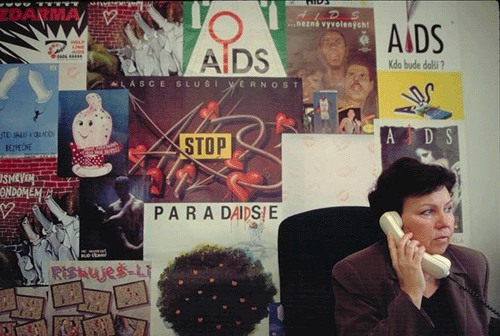
The project’s effects extend beyond a boost in self-esteem for their workers. Sonagachi began in 1992 when HIV prevalence in the district was low. While prevalence has increased over the years, the increases are small in comparison to other areas of West Bengal. In a 1998 effectiveness study, 503 brothel workers were randomly sampled and given HIV tests. Only 5.5 percent were found to be HIV positive. In addition, levels of recent syphilis infection declined from 25 percent to approximately 12 percent over the six-year period, and genital ulcer prevalence decreased from six percent to between one and two percent. The behavioral changes brought about by Sonagachi are also astounding. Condom usage is the major preventative behavior encouraged by the project. Of the sex workers surveyed in 1998, 90.5 percent were using condoms on a consistent basis, compared with 2.7 percent in 1992. Of that 90.5 percent, 50.4 percent always used a condom. The accuracy of these figures is heightened by the fact that condom usage was monitored via condom sales rather than self-reported usage as poor women are not likely to buy condoms that they will not actually use. The gains Sonagachi has made in the area of HIV/STD prevention are the direct result of its treating women in prostitution as people instead of pariahs. Mark Dybul, deputy coordinator and chief medical officer for the Bush administration’s global AIDS initiative, claims that we can condemn the work without condemning the workers. The truth is that the US anti-prostitution pledge promotes a return to heavy stigmatization of sex workers as the agents of infection, rather than a group of women highly vulnerable to being infected. As women, the effects of this discrimination will be doubly disempowering. If organizations like Sonagachi bow to US demands, there is no doubt that their AIDS programs will move several steps backwards. Not only will sex workers' access to health education and health care become more restricted, but prostitution will also be forced further underground. Studies have shown that the more clandestine the practice of prostitution, the higher the likelihood of sex worker repression and abuse, which increases the risk of HIV transmission. Another formidable possibility is that client, pimp, and police violence towards sex workers will increase. It is important to note that it was police violence, not HIV, which served as the catalyst for sex workers in India and other countries to organize in the first place. An association in Porto Alegre, Brazil called The Center for the Study of Prostitution emerged in response to reports of police applying shocks to the breasts and vaginas of the city’s female sex workers. The effects of stigmatization do not end with the sex worker herself. Children of women in prostitution already suffer from a stigma, which will only worsen if their mothers are further marginalized. Some boarding schools will deny admission to a child on the basis of his or her mother's being “a criminal,” and others require HIV tests before they will consider admitting sex workers' children because they are seen first and foremost as “potential carriers” (Born Into Brothels). Even when the children of sex workers do attend school, they are subject to playground teasing. As Vijay Kamble of Miraj recounts, “It is very painful to listen to your peers make snide remarks about your own mother. When my own teacher came to the community for sex, I ran and ran till I was breathless. I was so frightened. I never went back to school”. In the end, everyone with AIDS might suffer from a revived stigma. The portrayal of sex workers as agents of disease and “immoral whores” reinforces the myth that AIDS itself is a mark of impurity or immorality.
However, to view the USAID policy on prostitution solely as a moral crusade neglects the more subtle political advantages the US gains by using prostitution as a scapegoat for larger social problems. The connection being made between AIDS and prostitution masks the more important connection between AIDS and poverty in the societies hit hardest by the pandemic. Calcutta, for example, known by some as the “city of joy,” is also an incredibly crowded place, with large segments of the population in the throes of poverty. Incomes in Sonagachi ranged from 26 US cents to 51 US dollars per night in 1998, with only the youngest and most attractive women falling in the highest income bracket. But money is only one thing the women of Sonagachi lack. Women in general lack status in Bengali culture. This culture honors traditional class and caste hierarchies, a byproduct of which is the severe oppression of women and their relegation to the lowest status. Women are further disempowered once in “the game.” In the chhukri system, sex workers are controlled by a madam, and they must either make enough to pay off the cash advance given to them by the madam when they entered the brothel, or make enough to pay the people who sold them into bondage. In the adhia system, 50 percent of each brothel worker’s profits goes directly to the madam. In the pimp-controlled mukia system, the head of the pimp hierarchy receives 25 percent of each of his workers’ profits. Even in crowded brothels, women live in isolation, since madams and pimps enforce rules forbidding workers to speak with one another. Sonagachi sex workers also complain of a lack of control while working with some clients, especially when they are hired for group sex. Finally, while on the street the women must fend off the violence perpetrated against them by gundas, or hoodlums, which is usually ignored by the police. The lesson here is that we should not be asking why women choose a life of prostitution, but rather what these women lack to be able to live and work in a setting where there is less risk to their health and physical safety. Sonagachi has begun to address all of these deficiencies by serving as a much-needed social outlet for women in prostitution to work collectively towards bettering their health and their social situation. One-third of established peer educators have chosen to leave prostitution completely, supporting themselves with the modest stipends they receive from the project and the sale of small crafts at markets. Individual sex workers who remain in the trade are asserting their right to protection from STDs with clients, and their right to freedom from abuse and harassment with police, gundas, and swindling brothel landlords. The number of madams and pimps is also steadily declining, with many sex workers moving into hotel or residential-based sex work where they are their own bosses. Programs like Calcutta’s Sonagachi Project and Brazil’s world-renowned National Program, which meet the needs of women in prostitution, have encouraged real commitment to HIV prevention. We can only hold out hope that alternative funding sources will fill in the gap left behind by USAID.
References: | |
